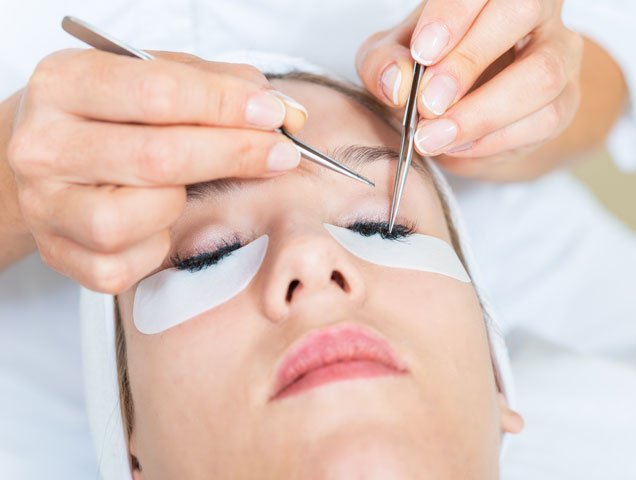A few months ago, Arielle Nachmani of Something Navy mentioned on Instagram that while she loves the look of eyelash extensions, she wishes she had never started getting them because they’ve ruined her lashes. Shortly thereafter a dermatologist mentioned to us that he has seen an increase in women coming into his office asking what they can do post-lash extension damage. So, what’s the deal?
Why are eyelash extensions dangerous?
“The chemical in most eyelash extension glue is formaldehyde — it’s always a concern when a strong chemically based formula is being used so close to the eye,” says Andrea Fairweather, founder of Fairweather Faces. If the lash technician gets too close to the eye, for example, it can easily cause infection. In fact, Fairweather says most people have a sensitivity to formaldehyde and while there are not different “types” of extensions (they all use formaldehyde), the process may take longer if you want more drama. “When you opt for more dramatic lashes versus more natural-looking ones, the process usually takes longer and therefore comes with a bigger risk,” says esthetician Sang W.
What can happen when eyelash extensions go wrong?
Aside from infection resulting from glue getting too close to eyes, you can get an infection because the extensions themselves trap bacteria and fungi for weeks to months (depending on how long you wear the extensions). “In addition, they can irritate the skin of the eyelid as well as the eye itself,” says Dr. Debra Wattenberg. “Sometimes we see a contact allergy to the glue or the actual lashes, which can cause swelling and redness. If a reaction is particularly bad, we can see loss of the person’s own eyelashes (bald spots) or a traction alopecia.” Wattenberg also notes that even if you don’t have a reaction, there’s still the risk of traction alopecia from the pulling on the lashes. If you must opt for regular extensions, she suggests doing them no more than every four to six weeks, or longer.
How to maximize safety?
As mentioned, pulling on lashes/rubbing your eyes is a big no-no when wearing lash extensions. “The lashes cannot be rubbed, pulled or even get wet while a person is wearing them,” says Fairweather. Waterproof mascara is another major no-no, especially if you don’t have a great remover, as you’ll end up losing lashes taking off your makeup.
Wattenberg adds that it’s really important to change mascara every three months, change or wash eyeshadow brushes and clean eyeliner pencils because all of these can carry bacteria and increase the risk of infection. “If you notice irritation or your eyes swell or feel uncomfortable, have the lashes removed and, depending on the reaction, see a dermatologist for a steroid or antibiotic to clear up the condition,” says Wattenberg. “Don’t let it linger too long as permanent scarring has occurred in some patients with extreme reactions.”
Celebrity makeup artist Suzy Gerstein recommends using a great non-waterproof mascara, like Lash Star Beauty’s Full Control Lash Sculpting Mascara. “If you must apply waterproof mascara, do that as a second coat once you have the base coat down so it’s less damaging to lashes and removes easier.” She also recommends conditioning lashes every night after removing makeup. “I like Sky Organics Castor Oil applied with a clean mascara spoolie (which you can find in most drugstores). Eye cream, as long as it’s very gentle and free from actives like retinol, also works well.” As mentioned, having an excellent makeup remover is key: she suggests opting for one designed specifically for removing waterproof and water-resistant eye makeup.
“Use two of the softest cotton wool pads you can find and generously apply your remover to both, then sandwich lashes top and bottom with your two pads. Hold them there for a good 30 seconds to a minute to let them work their magic, then simply whisk away eye makeup. Follow with a splash of water and lash conditioner.”
What are safe eyelash extension alternatives?
If you decide to opt out of extensions, you can still have long lashes! “Latisse by Allergan was the first of its kind when it comes to eyelash enhancers,” says founder of DermWarehouse, Dr. Alan J. Parks. “It’s a prescription that was originally used for patients with glaucoma, but once they began using this they noticed their eyelashes starting to grow and now this product is marketed for that purpose.” He does caution that there is a downside. “There is a possibility of changing eye color, especially for those with light-colored eyes.”
RapidLash Eyelash Enhancing Serum is another option. “It uses a patented complex consisting of six highly effective ingredients, which are all specifically designed to condition, moisturize and fortify to enhance overall appearance of lashes and brows,” says Parks.
Lastly, he recommends y.L.skin Lash Advance Eyelash Conditioner. “In just four weeks, this clinically proven blend of proteins, vitamins and nutrients will allow your eyelashes to grow up to 82 percent thicker, longer, fuller and darker — this is a brand-new product on the market and it’s available without a prescription and is safe with no side effects.”
[ Next: Everything You Ever Wanted to Know About Eyelash Extensions ]




